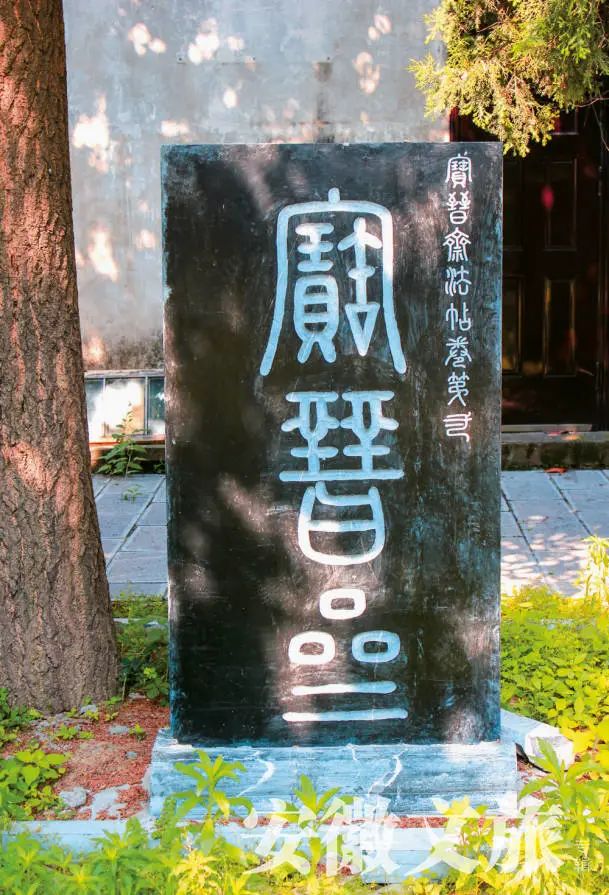
一群书法家,从无为米公祠回来,满是敬仰。
米公,是人们对米芾的尊称。米芾,北宋大书法家、画家,与蔡襄、苏轼、黄庭坚合称“宋四家”。他的《蜀素帖》,在书法界誉为天下第八行书。
宋太宗太平兴国三年(公元978年),朝廷在江北设置无为军,取“太平无为”之义。
无为有幸,宋徽宗崇宁年间,迎来了米芾为知军。
米芾为官清廉,勤政爱民,老百姓为感其德政,遂有了无为市西北隅的米公祠。1981年,被列为安徽省首批重点文物保护单位。

米芾拜石(王涛 绘)
Mi Fu worships the steles (painted by Wang Tao)
A group of calligraphers came back from the Lord Mi Memorial Temple in Wuwei, full of reverence and respect on their faces.
Lord Mi is a respectful appellation for Mi Fu, a great calligrapher and painter in the Northern Song Dynasty, who is known as one of the four calligraphy masters in the Song Dynasty togetherwith Cai Xiang, Su Shi and Huang Tingjian. His Shu sutie (a copybook for learning calligraphy) is hailed as No. 8 top cursive handwriting in the circle of calligraphers.
In the third year (978 AD) of Taiping Xingguo period under the reign of Emperor Taizong in the Song Dynasty, the imperial court set up an army in Wuwei to the north of the Yangtze namedWuwei Army, which embodied the wish of the court to do nothing militarily during a peaceful time.
Wuwei was luck because it had Mi Fu as its Zhijun (military commander and concurrently in charge of administrative governance) during the Chongning period under the reign of EmperorHuizong in the Song Dynasty.

米公祠墨池与投砚亭
The Ink Pool and the Inkstone Pavilion in Lord Mi Memorial Temple area
米公祠是在宝晋斋旧址上“挂牌”的。宝晋斋为米芾在担任无为县知军时所建。米芾崇尚晋人书法,在获得王羲之《王略帖》、谢安《八月五日帖》、王献之《十二月帖》墨迹后,视为珍宝,反复揣摩爱不释手,并自题斋名为“宝晋斋”,以收藏晋人书画作品。米芾将三家法帖摹刻上石,并在宝晋斋前掘池建亭,池谓之“墨池”,亭曰“投砚亭”。
如此,无为让后来的书家内心景仰。米芾在无为“投石止蛙”“米芾拜石”等故事,也代代相传,更是画家喜爱的题材。
今天的米公祠景区占地面积约17000平方米,总建筑面积约2660平方米,建有米公祠、宝晋斋、聚山阁、竹深处、古杏花泉井、墨池、投砚亭、拜石等历史景观。

古杏花泉井
The ancient Xinghuaquan(apricot flower + spring water) Well
Mi Fu was honest and upright in his post, working diligently in administration for the benefit of the locals. To commemorate his benevolent governance and achievements, people turned the official mansion in the northwest corner of the city proper into a memorial temple dedicated to him. In 1981, the Lord Mi Memorial Temple became one of the first heritage sites under provincial protection.

米芾《历子帖》(故宫博物院藏)
Lizi Copybook by Mi Fu (now in the collection of the Palace Museum)
The temple was on the original site of Baojinzhai, a house built for Mi Fu during his tenure of office in Wuwei. Mi Fu was fond of master-pieces of calligraphers in the Jin Dynasty. After obtaining such copybooks as Wangluetie by Wang Xizhi, the Copybook Made in August 5th by Xie An, and the Copybook Made in December by Wang Xianzhi, he treasured them so dear. To collect more calligraphy and painting works from the Jin Dynasty, he named his house Baojinzhai, which means "a house for the calligraphy treasures from the Jin Dynasty". Mi Fu had the three copybooks engraved on steles for further study. In addition, he had a pool dug and a pavilion built in front of the house. The pool He named Ink Pool and the pavilion "Inkstone Pavilion".
Thanks to the legends and legacy of Mi Fu, Wuwei becomes a place respected and admired by later calligraphers. The stories about Mi Fu throwing an inkstone to ban croaking of frogs and worshipping the steles have not only passed down from generation to generation, but also become favorite themes of painters.

“宝晋斋”碑
A stone tablet with the inscription of the name of the building
米公祠因米芾而存世,米芾也应官声和书画之声而活着。石刻可毁可烂,而落于人心中的怀念之情,永远挥之不去,存留永远。
走进米公祠,人们想见的是勤政为民的知军米芾,和传世的米芾书画作品,当然也有米芾拜石的场景。历史的痕迹在时光的流逝里清晰不灭,给人以启示和警醒,人过留名,雁过留声。米芾留给无为的是巨大的精神财富。

蜀素贴
Shu sutie (a copybook for learning calligraphy)
米公祠如今还珍藏着160余方晋唐以来历代名家碑刻,具有极高的文物和艺术价值,堪称古代书法艺术宝库。这也应源于米芾,没有米芾的宝晋斋,又何来今天的书法艺术宝库?这是无为之福,文化之幸。
米芾祖居太原,后迁湖北襄阳。米襄阳,这是襄阳老百姓送给他的雅号。襄阳也建有米公祠,其脉动和无为米公祠是一致的。

米公祠全景
A panoramic view of Lord Mi Memorial Temple
Today's Lord Mi Memorial Temple is a tourist attraction that covers a land area of about 17,000 square meters with a total floor space of 2,660 square meters. In the scenic area are such historical sites as the memorial hall, Baojinzhai, Jushan Tower, a secluded place in bamboo forest, an ancient well surround with apricot trees, the Ink Pool, the Inkstone Pavilion and the steles once Mi Fu worshipped.

米公祠内石刻(组图)
A stone inscription in Lord Mi Memorial Temple
In the scenic area, what people want to see are the diligent and good-hearted Zhijun Mi Fu and his painting and calligraphy works handed down through generations. Surely, some people would like to see the place where Mi Fu worshipped the steles. In the scenic area, there are more than 160 steles with the best works of famous calligraphers of the Jin and Tang dynasties engraved onthem, which are of high cultural and artistic value and regarded as treasures of ancient calligraphy.
The ancestral root of Mi Fu was in Taiyuan of Shanxi before his family moved to Xiangyang, Hubei. Mi Xiangyang was a refined salutation to him by the people of Xiangyang. There is also a Lord Mi Memorial Temple there, which shares the same function as the one in Wuwei.
文字:张建春 图片:李相贵 汪映成










